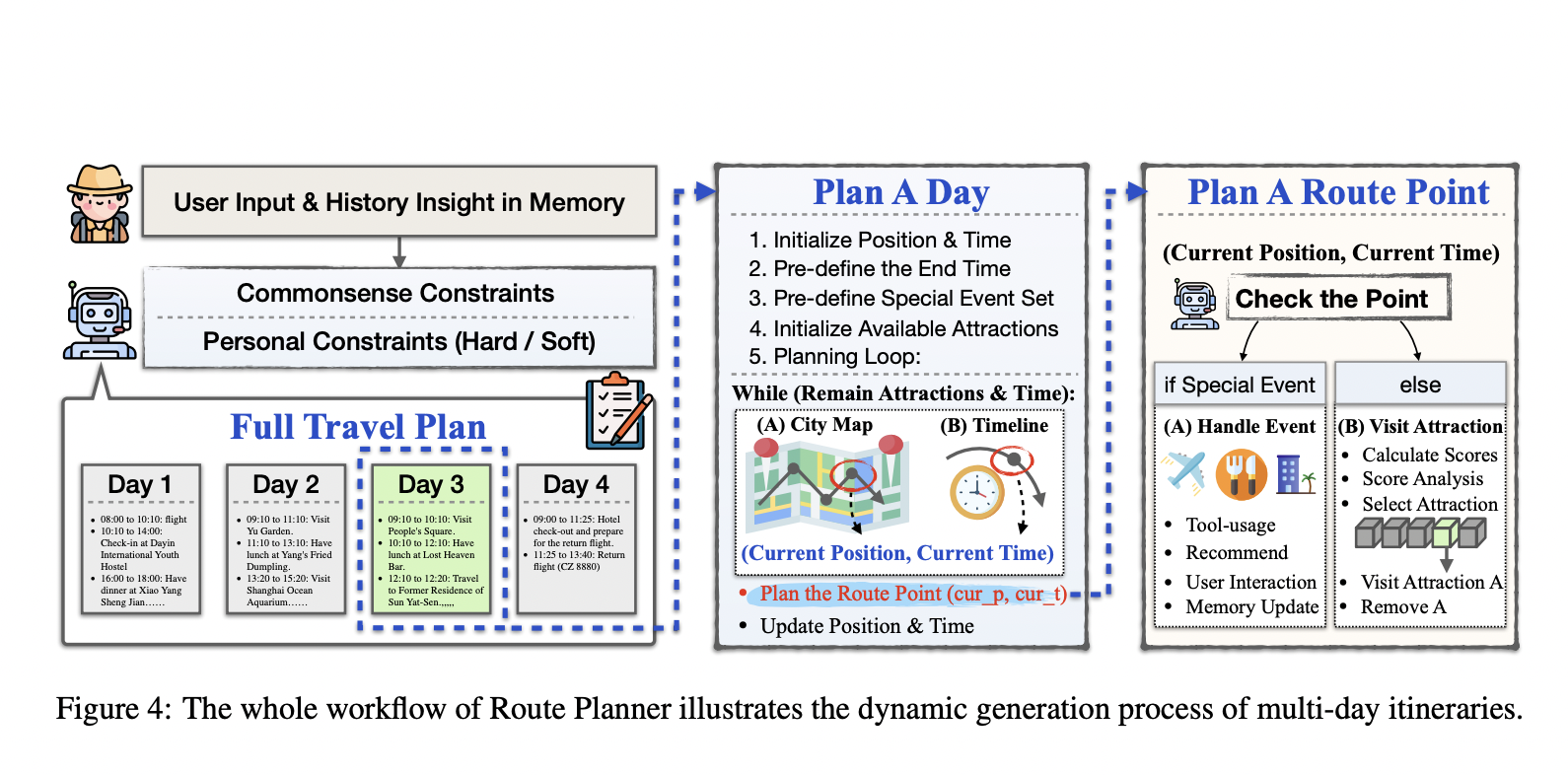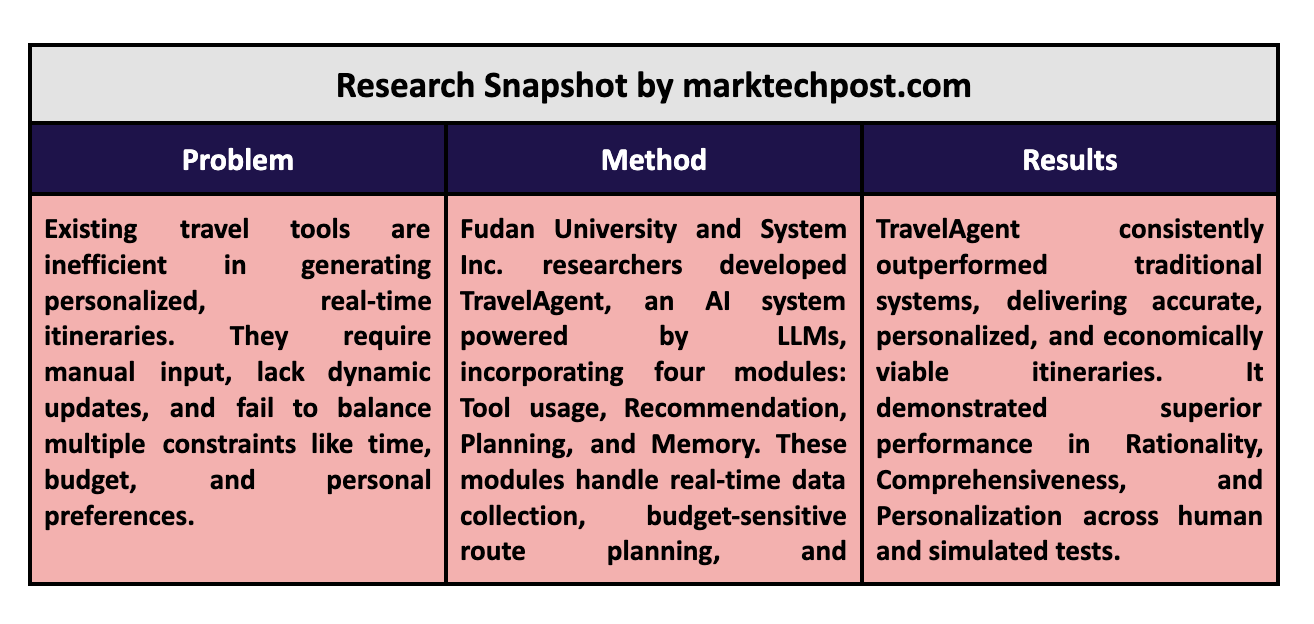

With the surge in global tourism, the demand for AI-driven travel assistants is rapidly growing. These systems are expected to generate practical and highly customized itineraries to individual preferences, including dynamic factors such as real-time data and budget constraints. The role of AI in this area is to improve the efficiency of the planning process and personalize travel experiences by incorporating user-specific needs and preferences. Travelers today expect more than just basic suggestions; they want a fully optimized, seamless experience that integrates all aspects of their journey into one comprehensive system.
One of the major challenges in travel planning is the need to balance several key constraints: time, budget, and user preferences. Current tools on the market are either static or require manual input, making them inefficient for users who need tailored travel plans that respond to real-time changes. Moreover, these systems often need to consider evolving personal preferences or adjust plans dynamically as new information becomes available. The inability to generate flexible, real-time solutions leaves a gap in the market for an AI-based solution that can deliver fully customizable itineraries that meet a range of user needs while considering multiple variables.
Traditional travel platforms like Expedia and Booking.com have established a basic framework for travel planning by offering categorized options such as hotels, flights, and attractions. However, these platforms require users to sift through choices manually, and they cannot generate and optimize entire itineraries automatically. For example, while they provide filtered recommendations, they rely heavily on user input, meaning travelers must make individual selections rather than receiving an integrated, well-rounded plan. These systems can also not adjust to dynamic situations, such as last-minute changes in travel conditions, or handle multiple constraints simultaneously.
A team of researchers from Fudan University and System Inc. developed TravelAgent. This novel AI-based travel planning system leverages large language models (LLMs) to generate personalized, dynamic itineraries. TravelAgent was specifically designed to address the limitations of existing tools by offering a more intelligent, comprehensive solution. The system introduces several innovations, including managing real-time updates and adapting to complex user constraints. TravelAgent integrates four distinct modules, Tool-Usage, Recommendation, Planning, and Memory, to ensure that every travel experience is optimized for individual preferences. These features enable the system to provide rational, comprehensive, and personalized travel services in a way that previous platforms could not.
The Tool-Usage Module accesses real-time tools to gather updated information on travel options, such as hotels and attractions. This module uses real-time APIs like Google Maps to ensure all recommendations are based on the latest data. The Recommendation Module then synthesizes this data to deliver personalized suggestions, while the Planning Module considers budget constraints to develop detailed route plans, optimizing travel time and geographic positioning. The Memory Module is crucial in personalizing the experience by storing short-term and long-term user preferences. For example, if a user consistently prefers eco-friendly attractions, this preference is stored and factored into future recommendations.
The system’s performance was rigorously tested in both human and simulated environments. The research team demonstrated through these evaluations that TravelAgent consistently outperforms traditional LLM-based systems across three core criteria: Rationality, Comprehensiveness, and Personalization. The results showed that TravelAgent adapts to real-time data and accurately reflects user preferences. In simulated user evaluations, the system exhibited a significantly lower error rate in personalized recommendations than its competitors, particularly in predicting user behavior for attraction suggestions. The system performed well in human case studies, proving its effectiveness in various travel scenarios. For example, the budget tool effectively allocated spending across six categories: accommodations, attractions, restaurants, transportation, other expenses, and a reserve fund, ensuring the travel plan was economically viable and tailored to the user’s needs.
Another key feature of TravelAgent is its ability to handle hard and soft constraints. Hard constraints, such as outbound and return dates or the composition of a travel group, are provided by the user and must be strictly followed. Soft constraints, such as personal preferences and evolving interests, are uncovered by the system over time through interactions with the user. This allows TravelAgent to continually refine its recommendations and adapt to the user’s changing needs. For instance, if a user prefers art museums, the system adjusts future itineraries to include more such recommendations. The system uses commonsense constraints, like preventing a restaurant from being visited twice in one trip, to ensure the itinerary remains logical and enjoyable.

Check out the Paper. All credit for this research goes to the researchers of this project. Also, don’t forget to follow us on Twitter and join our Telegram Channel and LinkedIn Group. If you like our work, you will love our newsletter..
Don’t Forget to join our 50k+ ML SubReddit
The post TravelAgent: Revolutionizing Personalized Travel Planning Through AI-Driven Itineraries with Real-Time Data, Dynamic Constraints, and Comprehensive User Preferences appeared first on MarkTechPost.